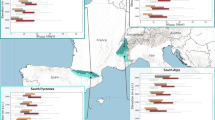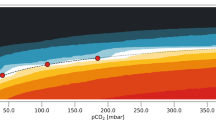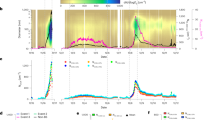Abstract
Westerly driven, long-range transportation of dust particles in elevated aerosol layers (EALs) is a persistent phenomenon during spring and summer over the Indian subcontinent. During the snow accumulation season, EALs transport substantial amounts of dust to the snow-covered slopes of high-mountain Asia (HMA). Here we use multiple satellite-based estimates to demonstrate a robust physical association between the EALs and dust-induced snow darkening over HMA. Results from a fully coupled atmosphere–chemistry–snow model support these observations, revealing across HMA a signature of increasing dust-induced snow darkening with surface elevation that peaks near 4,500 m. Moreover, the influence of dust on snow darkening is greater than that of black carbon above 4,000 m. Our findings suggest a discernible role of dust in the observed spatial heterogeneity of snowmelt and snowline trends over HMA and highlight an increasing contribution of dust to snowmelt as the snowline rises with warming.
This is a preview of subscription content, access via your institution
Access options
Access Nature and 54 other Nature Portfolio journals
Get Nature+, our best-value online-access subscription
$29.99 / 30 days
cancel any time
Subscribe to this journal
Receive 12 print issues and online access
$209.00 per year
only $17.42 per issue
Buy this article
- Purchase on Springer Link
- Instant access to full article PDF
Prices may be subject to local taxes which are calculated during checkout





Similar content being viewed by others
Data availability
MODIS data are available from https://modis.gsfc.nasa.gov/data/dataprod/. The CALLIPSO dataset used in this study can be downloaded from http://eosweb.larc.nasa.gov/. The AURA-OMI dataset used in this study can be downloaded from https://omisips1.omisips.eosdis.nasa.gov/. The MERRA-2 reanalysis data used in this study can be downloaded from http://disc.sci.gsfc.nasa.gov/daac-bin/FTPSubset2.pl. All processed data used in this study are archived at https://portal.nersc.gov/project/m1660/yang560/hma_dust/
Code availability
WRF-Chem is a community model freely available from https://github.com/wrf-model/WRF/releases. The WRF-Chem script modifications used in this study are archived at https://portal.nersc.gov/project/m1660/yang560/hma_dust/. Fig. 1a,b was prepared using ARC-GIS software. All other figures were prepared using MATLAB software. Code for data analysis and figure creation can be obtained from the corresponding author upon request.
References
Yao, T. et al. Recent third pole’s rapid warming accompanies cryospheric melt and water cycle intensification and interactions between monsoon and environment: multidisciplinary approach with observations, modeling, and analysis. Bull. Am. Meteorol. Soc. 100, 423–444 (2018).
Armstrong, R. L. et al. Runoff from glacier ice and seasonal snow in High Asia: separating melt water sources in river flow. Reg. Environ. Chang. 19, 1249–1261 (2019).
Guo, J. et al. Linking atmospheric pollution to cryospheric change in the third pole region: current progresses and future prospects. Natl Sci. Rev. 6, 796–809 (2019).
Bolch, T. et al. in The Hindu Kush Himalaya Assessment: Mountains, Climate Change, Sustainability and People (eds Wester, P. et al.) 209–255 (Springer, 2019).
Smith, T. & Bookhagen, B. Changes in seasonal snow water equivalent distribution in high mountain Asia (1987 to 2009). Sci. Adv. 4, e1701550 (2018).
IPCC Climate Change 2013: The Physical Science Basis. Working Group I Contribution to the Fifth Assessment Report of the Intergovernmental Panel on Climate Change 33 (Cambridge Univ. Press, 2014).
Painter, T. H., Seidel, F. C., Bryant, A. C., McKenzie Skiles, S. & Rittger, K. Imaging spectroscopy of albedo and radiative forcing by light-absorbing impurities in mountain snow. J. Geophys. Res. Atmos. 118, 9511–9523 (2013).
Qian, Y. et al. Light-absorbing particles in snow and ice: measurement and modeling of climatic and hydrological impact. Adv. Atmos. Sci. 32, 64–91 (2015).
McKenzie Skiles, S. & Painter, T. H. Assessment of radiative forcing by light-absorbing particles in snow from in situ observations with radiative transfer modeling. J. Hydrometeorol. 19, 1397–1409 (2018).
Qian, Y., Flanner, M. G., Leung, L. R. & Wang, W. Sensitivity studies on the impacts of Tibetan Plateau snowpack pollution on the Asian hydrological cycle and monsoon climate. Atmos. Chem. Phys. 11, 1929–1948 (2011).
Gautam, R., Hsu, N. C., Lau, W. K. M. & Yasunari, T. J. Satellite observations of desert dust-induced Himalayan snow darkening. Geophys. Res. Lett. 40, 988–993 (2013).
Yasunari, T. J. et al. Estimated range of black carbon dry deposition and the related snow albedo reduction over Himalayan glaciers during dry pre-monsoon periods. Atmos. Environ. 78, 259–267 (2013).
Nair, V. S. et al. Black carbon aerosols over the Himalayas: direct and surface albedo forcing. Tellus B Chem. Phys. Meteorol. 65, 19738 (2013).
Ménégoz, M. et al. Snow cover sensitivity to black carbon deposition in the Himalayas: from atmospheric and ice core measurements to regional climate simulations. Atmos. Chem. Phys. 14, 4237–4249 (2014).
Ming, J. et al. Black carbon record based on a shallow Himalayan ice core and its climatic implications. Atmos. Chem. Phys. 8, 1343–1352 (2008).
Usha, K. H., Nair, V. S. & Babu, S. S. Modeling of aerosol induced snow albedo feedbacks over the Himalayas and its implications on regional climate. Clim. Dyn. 54, 4191–4210 (2020).
Sarangi, C. et al. Impact of light-absorbing particles on snow albedo darkening and associated radiative forcing over high-mountain Asia: high-resolution WRF-Chem modeling and new satellite observations. Atmos. Chem. Phys. 19, 7105–7128 (2019).
Svensson, J. et al. Light-absorption of dust and elemental carbon in snow in the Indian Himalayas and the Finnish Arctic. Atmos. Meas. Tech. 11, 1403–1416 (2018).
Kaspari, S., Painter, T. H., Gysel, M., Skiles, S. M. & Schwikowski, M. Seasonal and elevational variations of black carbon and dust in snow and ice in the Solu-Khumbu, Nepal and estimated radiative forcings. Atmos. Chem. Phys. 14, 8089–8103 (2014).
Bonasoni, P. et al. Atmospheric brown clouds in the Himalayas: first two years of continuous observations at the Nepal Climate Observatory-Pyramid (5079 m). Atmos. Chem. Phys. 10, 7515–7531 (2010).
Vaishya, A. et al. Large contrast in the vertical distribution of aerosol optical properties and radiative effects across the Indo-Gangetic Plain during the SWAAMI–RAWEX campaign. Atmos. Chem. Phys. 18, 17669–17685 (2018).
Sarangi, C., Tripathi, S. N., Mishra, A. K., Goel, A. & Welton, E. J. Elevated aerosol layers and their radiative impact over Kanpur during monsoon onset period. J. Geophys. Res. Atmos. 121, 7936-7957 (2016).
Gautam, R., Hsu, N. C. & Lau, K.-M. Premonsoon aerosol characterization and radiative effects over the Indo-Gangetic Plains: implications for regional climate warming. J. Geophys. Res.—Atmos. 115, D17208 (2010).
Mishra, A. K. & Shibata, T. Climatological aspects of seasonal variation of aerosol vertical distribution over central Indo-Gangetic belt (IGB) inferred by the space-borne lidar CALIOP. Atmos. Environ. 46, 365–375 (2012).
Liu, Z. et al. Airborne dust distributions over the Tibetan Plateau and surrounding areas derived from the first year of CALIPSO lidar observations. Atmos. Chem. Phys. 8, 5045–5060 (2008).
Das, S., Dey, S., Dash, S. K. & Basil, G. Examining mineral dust transport over the Indian subcontinent using the regional climate model, RegCM4.1. Atmos. Res. 134, 64–76 (2013).
Warren, S. G. & Wiscombe, W. J. A model for the spectral albedo of snow. II: snow containing atmospheric aerosols. J. Atmos. Sci. 37, 2734–2745 (1980).
Warren, S. G. Optical properties of snow. Rev. Geophys. 20, 67–89 (1982).
Dang, C., Fu, Q. & Warren, S. G. Effect of snow grain shape on snow albedo. J. Atmos. Sci. 73, 3573–3583 (2016).
Hansen, J. & Nazarenko, L. Soot climate forcing via snow and ice albedos. Proc. Natl Acad. Sci. USA 101, 423–428 (2004).
Painter, T. H. et al. Response of Colorado River runoff to dust radiative forcing in snow. Proc. Natl Acad. Sci. USA 107, 17125–17130 (2010).
Skiles, S. M., Painter, T. H., Deems, J. S., Bryant, A. C. & Landry, C. C. Dust radiative forcing in snow of the Upper Colorado River Basin: 2. Interannual variability in radiative forcing and snowmelt rates. Water Resour. Res. 48, W07522 (2012).
Skiles, S. M. K. & Painter, T. Daily evolution in dust and black carbon content, snow grain size, and snow albedo during snowmelt, Rocky Mountains, Colorado. J. Glaciol. 63, 118–132 (2017).
Di Mauro, B. et al. Mineral dust impact on snow radiative properties in the European Alps combining ground, UAV, and satellite observations. J. Geophys. Res. Atmos. 120, 6080–6097 (2015).
Dumont, M. et al. In situ continuous visible and near-infrared spectroscopy of an alpine snowpack. Cryosph. 11, 1091–1110 (2017).
Huang, J. et al. Dust and black carbon in seasonal snow across northern China. Bull. Am. Meteorol. Soc. 92, 175–181 (2010).
Wang, X. et al. Observations and model simulations of snow albedo reduction in seasonal snow due to insoluble light-absorbing particles during 2014 Chinese survey. Atmos. Chem. Phys. 17, 2279–2296 (2017).
Zhang, Y. et al. Black carbon and mineral dust in snow cover on the Tibetan Plateau. Cryosph. 12, 413–431 (2018).
Warren, S. G. Can black carbon in snow be detected by remote sensing? J. Geophys. Res. Atmos. 118, 779–786 (2013).
Flanner, M. G., Zender, C. S., Randerson, J. T. & Rasch, P. J. Present-day climate forcing and response from black carbon in snow. J. Geophys. Res. Atmos. 112, D11202 (2007).
Doherty, S. J. et al. Observed vertical redistribution of black carbon and other insoluble light-absorbing particles in melting snow. J. Geophys. Res. Atmos. 118, 5553–5569 (2013).
Painter, T. H., Bryant, A. C. & McKenzie Skiles, S. Radiative forcing by light absorbing impurities in snow from MODIS surface reflectance data. Geophys. Res. Lett. 39, L17502 (2012).
Hadley, O. L. & Kirchstetter, T. W. Black-carbon reduction of snow albedo. Nat. Clim. Chang. 2, 437–440 (2012).
Brun, F., Berthier, E., Wagnon, P., Kääb, A. & Treichler, D. A spatially resolved estimate of High Mountain Asia glacier mass balances from 2000 to 2016. Nat. Geosci. 10, 668 (2017).
Zhao, H., Yang, W., Yao, T., Tian, L. & Xu, B. Dramatic mass loss in extreme high-elevation areas of a western Himalayan glacier: observations and modeling. Sci. Rep. 6, 30706 (2016).
Ji, Z. M. Modeling black carbon and its potential radiative effects over the Tibetan Plateau. Adv. Clim. Chang. Res. 7, 139–144 (2016).
Xu, J. et al. The melting Himalayas: cascading effects of climate change on water, biodiversity, and livelihoods. Conserv. Biol. 23, 520–530 (2009).
Ghatak, D., Sinsky, E. & Miller, J. Role of snow-albedo feedback in higher elevation warming over the Himalayas, Tibetan Plateau and Central Asia. Environ. Res. Lett. 9, 114008 (2014).
Bormann, K. J., Brown, R. D., Derksen, C. & Painter, T. H. Estimating snow-cover trends from space. Nat. Clim. Change 8, 924–928 (2018).
Ming, J., Xiao, C., Du, Z. & Yang, X. An overview of black carbon deposition in High Asia glaciers and its impacts on radiation balance. Adv. Water Resour. 55, 80–87 (2013).
Painter, T. H. et al. Retrieval of subpixel snow covered area, grain size, and albedo from MODIS. Remote Sens. Environ. 113, 868–879 (2009).
Rittger, K., Painter, T. H. & Dozier, J. Assessment of methods for mapping snow cover from MODIS. Adv. Water Resour. 51, 367–380 (2013).
Dozier, J., Painter, T. H., Rittger, K. & Frew, J. E. Time–space continuity of daily maps of fractional snow cover and albedo from MODIS. Adv. Water Resour. 31, 1515–1526 (2008).
Rittger, K., Bair, E. H., Kahl, A. & Dozier, J. Spatial estimates of snow water equivalent from reconstruction. Adv. Water Resour. 94, 345–363 (2016).
Chand, D. et al. Quantifying above-cloud aerosol using spaceborne lidar for improved understanding of cloudy-sky direct climate forcing. J. Geophys. Res. Atmos. 113, D13206 (2008).
Winker, D. M. et al. The CALIPSO mission. Bull. Am. Meteorol. Soc. 91, 1211–1230 (2010).
Gelaro, R. et al. The Modern-Era Retrospective Analysis for Research and Applications, version 2 (MERRA-2). J. Clim. 30, 5419–5454 (2017).
Molod, A., Takacs, L., Suarez, M. & Bacmeister, J. Development of the GEOS-5 atmospheric general circulation model: evolution from MERRA to MERRA2. Geosci. Model Dev. 8, 1339–1356 (2015).
Buchard, V. et al. Using the OMI aerosol index and absorption aerosol optical depth to evaluate the NASA MERRA Aerosol Reanalysis. Atmos. Chem. Phys. 15, 5743–5760 (2015).
Derber, J. C., Parrish, D. F. & Lord, S. J. The New Global Operational Analysis System at the National Meteorological Center. Weather Forecast. 6, 538–547 (1991).
Herman, J. R. et al. Global distribution of UV-absorbing aerosols from Nimbus 7/TOMS data. J. Geophys. Res. Atmos. 102, 16911–16922 (1997).
Huang, J., Ge, J. & Weng, F. Detection of Asia dust storms using multisensor satellite measurements. Remote Sens. Environ. 110, 186–191 (2007).
Sun, H., Liu, X. & Pan, Z. Direct radiative effects of dust aerosols emitted from the Tibetan Plateau on the East Asian summer monsoon—a regional climate model simulation. Atmos. Chem. Phys. 17, 13731–13745 (2017).
Zaveri, R. A., Easter, R. C., Fast, J. D. & Peters, L. K. Model for simulating aerosol interactions and chemistry (MOSAIC). J. Geophys. Res. Atmos. 113, D13204 (2008).
Flanner, M. G., Liu, X., Zhou, C., Penner, J. E. & Jiao, C. Enhanced solar energy absorption by internally-mixed black carbon in snow grains. Atmos. Chem. Phys. 12, 4699–4721 (2012).
Zhao, C. et al. Simulating black carbon and dust and their radiative forcing in seasonal snow: a case study over North China with field campaign measurements. Atmos. Chem. Phys. 14, 11475–11491 (2014).
Acknowledgements
This research was primarily supported by the NASA High Mountain Asia Project. NASA Applied Sciences 2017 GEO Award 80NSSC18K0427 supported part of this work. C.S. thanks M. Alaa for his inputs and help with ARC-GIS for plotting Fig. 1a and B. C.S. is also partially supported by the New Faculty Initiation Grant project number CE/20-21/065/NFIG/008961 from IIT Madras. The Pacific Northwest National Laboratory (PNNL) is operated for DOE by Battelle Memorial Institute under contract DE-AC06-76RLO 1830. Part of this work was performed at the Jet Propulsion Laboratory, California Institute of Technology under contract with NASA.
Author information
Authors and Affiliations
Contributions
C.S. and Y.Q. conceived the study. C.S. did the analysis and wrote the initial manuscript under the mentorship of Y.Q. Satellite retrieval of MODSCAG and MODRFFS products were provided by K.R., K.J.B. and T.H.P. The CALIPSO data were provided by D.C. All authors provided inputs during manuscript preparation and revision.
Corresponding authors
Ethics declarations
Competing interests
The authors declare no competing interests.
Additional information
Publisher’s note Springer Nature remains neutral with regard to jurisdictional claims in published maps and institutional affiliations.
Supplementary information
Supplementary Information
Supplementary Figs. 1–11.
Rights and permissions
About this article
Cite this article
Sarangi, C., Qian, Y., Rittger, K. et al. Dust dominates high-altitude snow darkening and melt over high-mountain Asia. Nat. Clim. Chang. 10, 1045–1051 (2020). https://doi.org/10.1038/s41558-020-00909-3
Received:
Accepted:
Published:
Issue Date:
DOI: https://doi.org/10.1038/s41558-020-00909-3
This article is cited by
-
Glacier retreat and lake outburst floods in the central Himalayan region from 2000 to 2022
Natural Hazards (2024)
-
A cleaner snow future mitigates Northern Hemisphere snowpack loss from warming
Nature Communications (2023)
-
Precipitation regime changes in High Mountain Asia driven by cleaner air
Nature (2023)
-
Aerosol-CCN characteristics and dynamics associated with a pre-monsoon dust storm over a high-altitude site in Western Ghats, India
Environmental Science and Pollution Research (2023)
-
Trace Metals and Polycyclic Aromatic Hydrocarbons in the Snow Cover of the City of Nizhnevartovsk (Western Siberia, Russia)
Archives of Environmental Contamination and Toxicology (2023)



